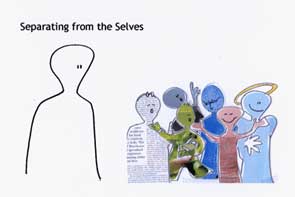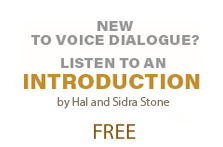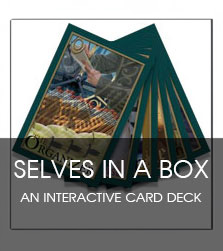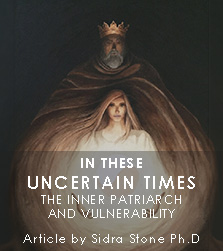by Hal Stone, Ph.D. & Sidra Stone, Ph.D.
This article is the first in a series of four written in 1994 for the journal, Psychotherapy in Australia.
There is a mysterious realm within each of us that alternately beckons and frightens the explorer with its depth, its complexities and its sometimes startling contradictions.
This kingdom of the psyche and its many disparate facets has long been a source of fascination to us. In the early seventies we discovered that the psyche contained many individual selves, each with its own way of perceiving the world, each with its own personal history, physical characteristics, emotional and physical reactions, and opinions on how we should run our lives.
We have spent much of our time, both professional and personal, in exploring these selves which determine, to a considerable extent, the course of our lives. We have found that the more sharply we become attuned to these inner voices, the more real choice we are able to exercise in the pursuit of our individual destinies.
The Birth of Personality
Let us begin with a consideration of the
development of personality and the pivotal role
that vulnerability plays in each of our lives. We
are all born totally vulnerable and, in our early
years, we must be cared for by other people. Our
very lives depend upon this. Therefore, we begin,
as early as possible, to develop a personality that
will help us to protect this vulnerable core, this
inner child that lives within each of us. This
inner child is with us forever. It never grows up
and we are always responsible for its well being.
The way we take care of this child is a major
factor in determining the kind of personality we
develop.
Very early in our lives a ‘self ’ begins to develop to protect this child, a self that we call the Protector/Controller. It looks around and begins to determine what behavior is safe for the child and what behavior is likely to bring physical or emotional pain. It notices what behavior is rewarded and what is punished. It figures out the roles of the world around us so that this world is predictable and makes sense, and sets up an appropriate code of behavior for our specific environment. When it is functioning appropriately it changes its rules to accommodate any new input. It helps to keep life coherent, and is basically rational in nature. It becomes the Operating Ego or the cornerstone of our personality. Along with the other primary selves that develop to support it, it represents who we are in the world.
As time moves on, other parts of the personality develop, each contributing its flavor to this Operating Ego. A Pusher may develop to make sure we get done what has to be done— and more besides. If it pushes hard enough then we will be so successful that no-one can criticize us or attack us. A Pleaser generally develops that makes sure we are nice to people and thus our child remains safe. An Inner Critic develops to keep us living properly according to the laws of this Protector/ Controller, or, perhaps, an inner Rule Maker. Each of these selves develops in relationship to, and under the aegis of, the original Protector/Controller. Together they comprise what is known as the primary self system and it is this primary self systems that defines who we are in the world to ourselves and to others.
Primary Selves, Disowned Selves
and the Aware Ego
What is generally seen as ‘the ego’ or as one’s
personality in general, is basically the Protector/
Controller and the primary selves around it. By
definition, the job of the ego is to provide a good
executive function for the psyche. It needs to
make choices, like a good CEO. It needs to drive
our psychological car, to attempt to bring order
to the conflicting parts of the psyche.
If, however, the ego is the Protector/ Controller in conjunction with the Pleaser and Pusher and Rational Selves, then the choices made in life come from the consciousness and basic psychology of these particular selves that comprise this Operating Ego. It is this Operating Ego that spiritually oriented disciplines are trying to eliminate when they advise us to eliminate the ego so that our spiritual development can proceed. This domination by the primary selves which make up the Operating Ego means that there will be contrasting selves of equal and opposite energy that are disowned or repressed. For instance, if the Protector/Controller has helped a man develop a strong Pusher in order to make him successful in the world, on the other side will be a less developed or even a disowned system of selves associated with playfulness, relaxation or lack of ambition.
The primary selves vary from family to family,
culture to culture, and can even change in the
course of our lives. The most common personality
developed in our culture is one in which there is
a strong Protector/Controller, and vulnerability
has been largely disowned. In this way, the
primary selves allow an individual to operate in
the world  with authority and power and one is less likely to be hurt or victimized. These primary
selves are the selves that we identify with. The
selves that lose out in this process are ones that
have to do with vulnerability, sensitivity, shyness,
‘being’ (rather than “doing’), and the expression
of real feelings and emotions. These are the selves
that are seen as subversive and possibly even
dangerous by the more powerful primary selves
and which are disowned.
with authority and power and one is less likely to be hurt or victimized. These primary
selves are the selves that we identify with. The
selves that lose out in this process are ones that
have to do with vulnerability, sensitivity, shyness,
‘being’ (rather than “doing’), and the expression
of real feelings and emotions. These are the selves
that are seen as subversive and possibly even
dangerous by the more powerful primary selves
and which are disowned.
Jane is a 35 year old woman very much identified with her mother role in life. She took on this role as early as three years of age, a fairly common pattern in dysfunctional families. She was always available to people and doing things for them and never gave priority to her own needs. Her Responsible Mother Self and Pleasing Daughter were primary and her Selfish Self and her Vulnerable Child were both disowned. How is Jane to ever know that she has these disowned selves? Her concept of herself or Operating Ego is this Pleasing Daughter and Responsible Mother. This is also how she is seen by the world around her. She feels basically secure in her identification with this role. It is true that she has migraine headaches and is not sleeping well at night, and that her marriage has also gone quite dead. Since her primary selves determine her perceptions of the world, however, she would not connect the actions of these selves to any of her problems.
The primary selves are the window or the glasses through which each of us sees the world. They represent our Operating Ego until we do the work that separates us from their limited reality and thus give birth to what we term as a new Aware Ego. This Aware Ego is constantly separating from the primary selves and thus becomes able to embrace them, and the disowned selves on the other side, without being identified with either.
The Development of The Aware Ego All consciousness work at some level is working with primary and disowned selves. Discovering the primary selves is difficult since they represent

who you are in the world and the way to discover
your primary selves is to begin by discovering
your disowned selves. Just take a moment and
ask yourself the following questions. Who
is it in your life that pushes your emotional
buttons? Whom do you judge? Conversely, who
is so wonderful that you are a mere nothing
in comparison? If you can discover and isolate
the quality or qualities that push your buttons
negatively, or that you overvalue positively, then
you have one or more of your disowned selves
available to you.
Generally speaking, we are very negatively
related and judgmental towards people who carry
our disowned selves or, on the other hand, we are
fascinated by them. Whatever the case, and of
this you may be sure, life will bring our disowned
selves to us repeatedly until we are able to claim
them as our own. One of Jane’s disowned selves
is carried by people who are selfish and think
only of themselves. Her oldest daughter and her
younger sister live this self out for her; they are
both teachers for her. She has much conflict... continue
©1994







